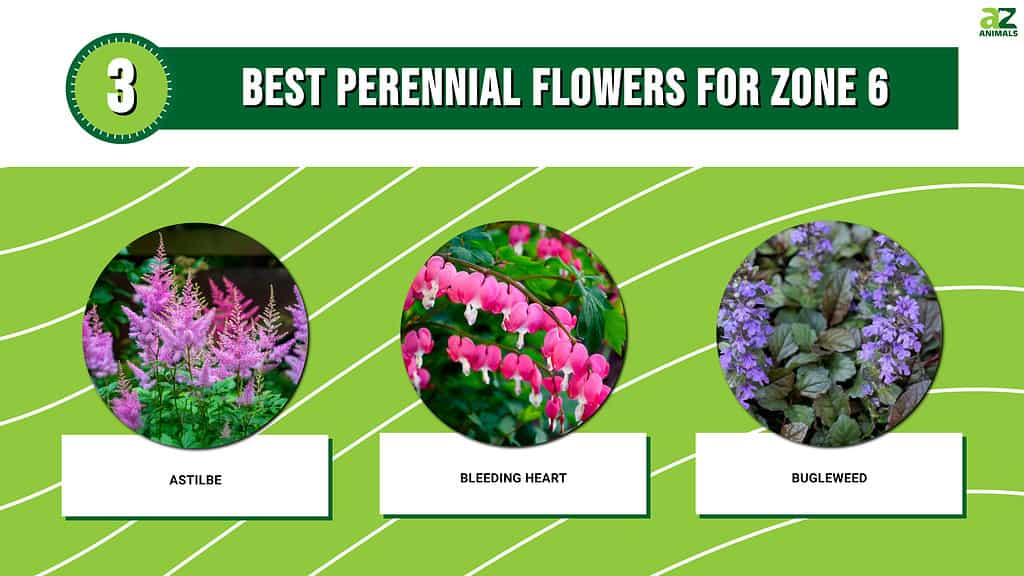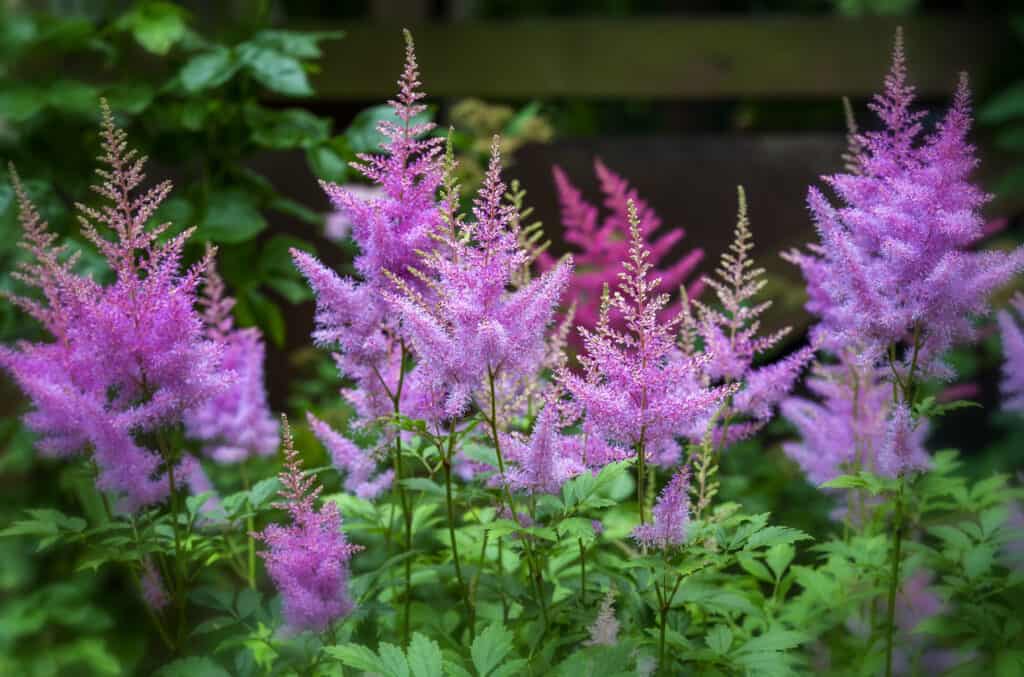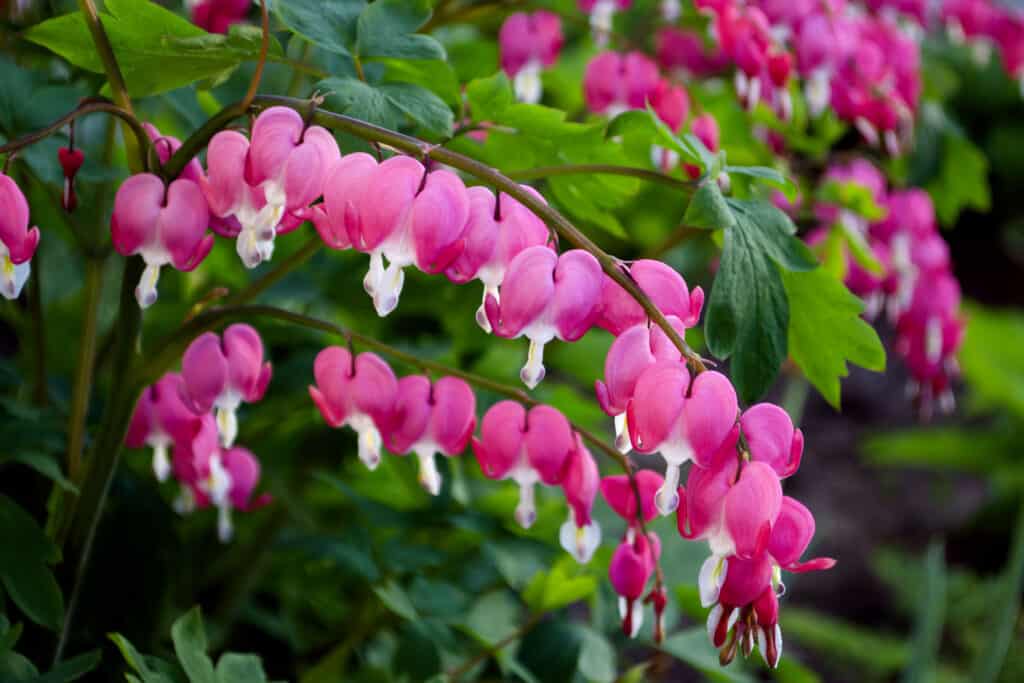Catmint has a captivating fragrance. Imagine sage mingling with mint, and you’ll be on the right track. The leaves are also very soft, and the flowers are a beautiful lavender color. It’s a great plant to have around if you have cats, as they love to roll in it and rub against the soft foliage.

Catmint is one of the best perennial flowers for zone 6. In colder climates, the flowers die back to the ground in winter but will come back up in the spring.
What other perennials can withstand zone 6 temperatures? Read on to find out!
1. Astilbe

Astilbe flowers handle water well and are often used to frame ponds.
©iStock.com/Sansargo
Astilbe is a splendid plant for zone 6 temperatures. With their fern-like foliage and feathery plumes in shades of pink, red, purple, or white, astilbes are show-stoppers. These popular perennials come in various heights, from six inches to five feet.
Astilbes prefer shady and moist sites—a fact that may seem at odds with their delicate appearance. But with enough moisture, these perennials will thrive, and their foliage will remain attractive throughout the blooming period. To keep your astilbes healthy, water them deeply once or twice a week during hot weather. Mulching with organic material such as wood chips will also help retain moisture and protect the roots from extremes in temperature.
Astilbes come in various colors, from the deep pink of bressingham beauty to the white flowers of snowdrift. No matter what your garden’s color palette is, there’s astilbe that will fit right in. These plants are also versatile in height, so you can choose a dwarf variety for a small space or a taller one for impactful floral displays.
2. Bleeding Heart

Avoid placing bleeding hearts in areas that tend to stay soggy.
©iStock.com/Oksana Akhtanina
Bleeding hearts prefer partial to full shade—meaning they need at least four hours of sunlight per day but prefer six to eight hours. They’ll also do well in dappled sunlight (lightly filtered through trees). These woodland plants are native to North America and Asia, so they’re accustomed to growing in shady areas beneath trees.
When choosing a spot in your garden for planting, remember that bleeding hearts dislike being moved once they’ve been established, so choose a location carefully. They also don’t care for overly wet soils, so avoid placing them in areas that tend to stay soggy after rainstorms. Well-drained soil is best.
With these needs in mind, some good places to plant bleeding hearts include:
- Along the north or east sides of buildings where they’ll receive protection from the hot afternoon sun.
- Beneath deciduous trees (trees that lose their leaves each year), where they’ll receive dappled sunlight throughout the day.
- In shaded rock gardens or wooded areas.
- At the base of taller shrubs or evergreens, where they’ll receive some shelter from the wind.
Bleeding hearts are generally easy to grow and care for once established. They don’t require much fertilizer and are relatively drought-tolerant once they’re mature. When planting, space seedlings 12 to 18 inches apart when planting them in your garden bed or elsewhere in your landscape. This will give them room to grow without crowding out other nearby plants.
3. Bugleweed

The bugleweed is a perennial that grows easily.
©iStock.com/Albin Raj
Bugleweed is the perennial you didn’t know you needed. It is a groundcover plant that grows quickly and spreads easily, making it perfect for filling bare spots in your garden. Bugleweed is also known as carpetweed, ground pine, blue bugle, and hogweed. The incredible perennial is even showing help in the medical world, combating all sorts of issues like thyroid problems.
Bugleweed typically grows to be 6-12 inches tall. Most gardeners enjoy purple or blue flowers, but there are also varieties with white or pink flowers. The leaves are dark green and glossy, and they stay evergreen all year round in most climates.
Bugleweed is native to Europe and Asia, but it now grows all over the world. It’s a tough plant that can tolerate a wide range of conditions, but it grows best in well-drained soil that’s moist but not waterlogged.
Caring for bugleweed is easy! This plant is very tolerant of drought, so you don’t need to worry about watering it regularly. In fact, too much water can actually damage bugleweed by causing the leaves to turn yellow or brown. Just make sure not to let the soil dry out completely.
Fertilizing isn’t necessary either, but you can give your plant a boost by spreading some compost around the base of the plant in early spring. To control its spread, simply snip off any runners that appear outside the area where you want the plant to grow.
Summary Of 3 Best Perennial Flowers For Zone 6
Here is a list of 3 best perennial flowers for zone 6:
| Rank | Flower | Growing Conditions | Maintenance |
|---|---|---|---|
| 1 | Astilbe | Prefer shady and moist sites | Water deeply 1-2 times per week in hot weather. Mulching with wood chips helps retain moisture. |
| 2 | Bleeding Heart | Partial to full shade or dappled sunlight. Plant seedlings 12-18 inches apart. | Dislike being moved once planted so choose location carefully and avoid placing in areas that stay soggy after rainstorms. Well-drained soil is best. Don’t require much fertilizer. |
| 3 | Bugleweed | Can tolerate a range of conditions and grows best in well-drained soil | Too much water can turn leaves brown or yellow. Fertilizing isn’t necessary, but compost around plant base in early spring gives a boost. |
The photo featured at the top of this post is © iStock.com/Albin Raj
Sources
- Utah State University, Available here: https://extension.usu.edu/yardandgarden/soils
Thank you for reading! Have some feedback for us? Contact the AZ Animals editorial team.






